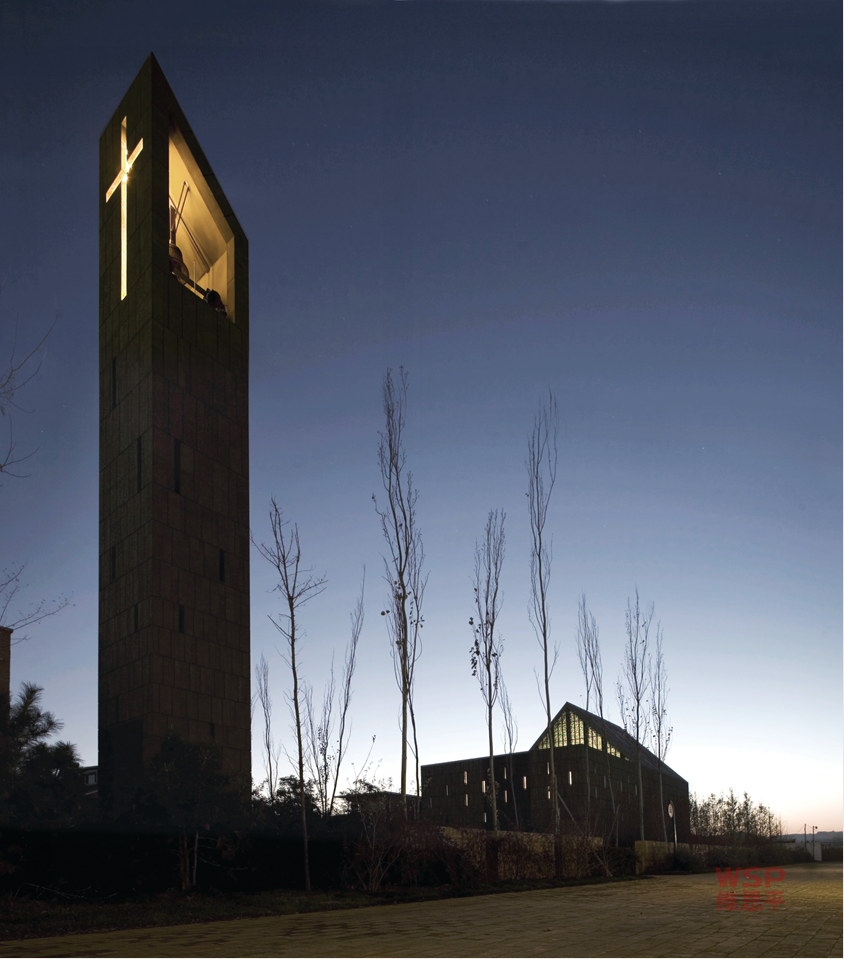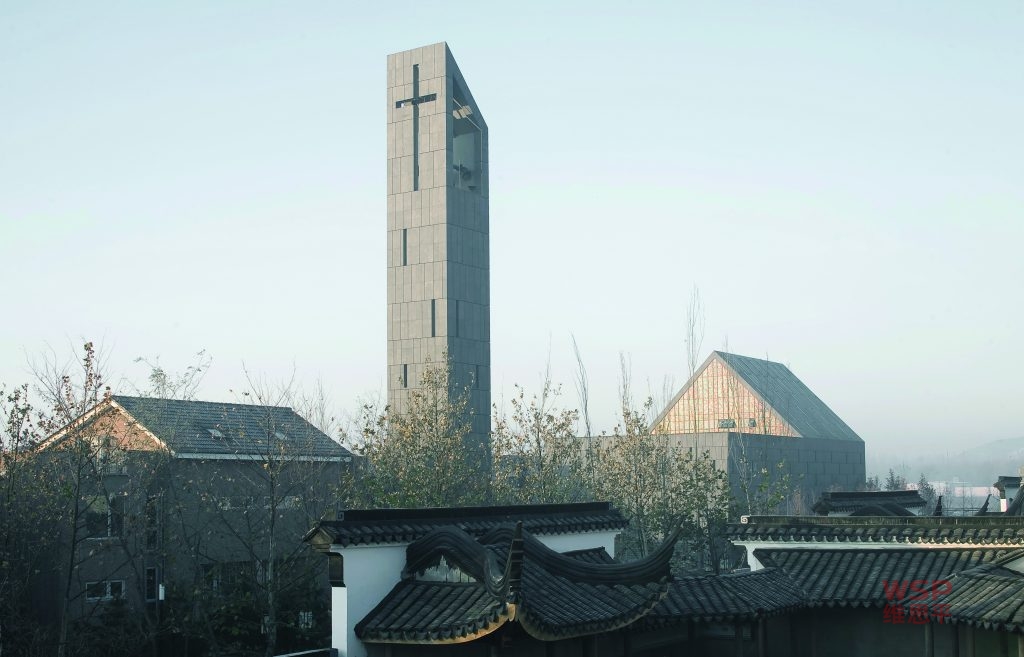龙山教堂项目短评 | PROJECT REVIEW OF LONGSHAN CHURCH
点击:1,634 次 来源:WSP 时间:12-16
龙山教堂是一个很重要的项目。教堂陡峭的45度坡屋顶从灰色石墙整体长度的一半处开始升起,瞬间闪过的印象旋即反映出这座身处欧洲小镇景观中的朴素建筑选址的敏感性。然而,经过进一步仔细观察,饰面材料充满挑战性的选择,卓越的细部设计,微观尺度的连接方式,以及用不熟悉的比例来处理复杂的室内空间,更精彩的设计一一呈现在眼前。上述不凡的设计也许要归因于设计师潜意识里对早期现代主义建筑先锋作品集大成的记忆,当然还有她的中国情结。钟塔远离教堂主体建筑,位于基地一侧,处在不对称的位置上,这种布局为阅读建筑的水平性和垂直性提供了清晰的划分。这意味着什么呢?是否在某处潜意识里结合了相关的中国文化?这些地方尚无从知晓。在这种语境下,我们应该通过多镜头文化研究、多元现代性与当代性来解读这个作品。
Longshan Church is an important project. A quick image of the Church with 450 steep roof rising above half the long grey stone wall reflects momentarily a sensitive setting of the modest building located on the European landscape. However, a more careful observation will show a challenging selection of material finishes, excellent detailing and micro-scale articulation as well as the complex interior treatment with unfamiliar proportions. Much of this could possibly be attributed to her subconscious collective memories of works by the early modernist pioneers, and her Chineseness. The asymmetrical location of the clock tower and on the edge of the site away from the church building has provided a clear separation in the reading of the horizontal and the vertical. What does this mean? Is there a Chinese cultural relevance subconsciously incorporated somewhere yet to be uncovered? It is in this context that we should examine this project through the lens of Cultural Studies, multi-modernities and contemporariness.
中国现状
China now
近30年来,中国东部地区很多重要城市都在经历着空前的大跨步新建,以及对老建筑的大规模毁坏。为了弥补过去几十年在艺术审美以及建筑理论与实践上的缺失,将时间压缩进行的现代化建设和迅速的城市化进程导致了盲目模仿行为遍地皆是,这样做的确很有效率,但是却失去了思想上最具创造性的自由革新。理论家已经在抱怨这种现状“正在丧失机遇”。与此同时,像张永和、吴钢等年轻一代的中国建筑师正在争取恢复更宽泛的现代建筑的视觉和审美原则。他们设计的一些朴素的建筑也开始在建筑品质上具有视觉影响力,也因此带动了当地的高校,并且为中国建筑界带来先进的创新元素。
In the last three decades, major cities in China’s Eastern region have experienced unprecedented pace of new construction and massive destruction of the old. To catch up with the lost decades of aesthetic and architectural theories and practices, the time-compression of modernization and rapid urbanization have resulted in indiscriminate act of imitation everywhere and even with efficiencies but without freedom of mind to innovate creatively. Theorists have lamented this “lost opportunity”. In the meantime, the younger generation of Chinese architects like Chang Yung-Ho, Wu Gang and others are battling to reinstate the broader aesthetic and visual principles of Modern Architecture. Their modest projects are beginning to have visible impact in the quality of architectural design in the leading local universities, and the progressive creative elements in the Chinese architectural fraternity.
奥林匹克
Olympics
在此期间,2008年奥运会为北京以及中国其他地方设计建造大型体育与娱乐项目提供了很多机遇。两位国际“超级巨星”,赫尔佐格和德梅隆合伙公司,以及雷姆·库哈斯都分别参与设计了位于北京的奥林匹克体育场和中央电视台新台大厦(CCTV)。在亚洲,这是为寻求创造瞬时效应的两个例证,只为带来旅游收入和世界级地位的印象。这两个项目都是最尖端的,而且是很重要的建筑表达方式,挑战已经建立的主流建筑规范。尽管中国提供了这样的机会,但他们根植于西方的饱受争议的设计理念正经历着有关建筑临界性的争论。此外,我们必须认识到,即使最杰出的国外建筑师创作出的优秀的作品,但那也不是标志性建筑。标志性的地位只能通过时间的磨砺、人的使用和集体的记忆而最终得到,它才会被当地公认为具有标志性和象征性。这两个项目对中国建筑理论著述的意义和贡献尚无从定论。
In the meantime, the coming Olympics in year 2008 have given many opportunities to design and build major projects for sports and recreation in Beijing and elsewhere in China. Two international super-stars, Herzog & de Meuron and Rem Koolhaas are involved in conceptualizing the design of the Olympic Stadium and Central Chinese Television (CCTV) respectively in Beijing. These two are examples in Asian quest to create instant icons in order to generate tourist revenues and imagery world-class status. Both projects are cutting-edge and important architectural statements, challenging the mainstream established norm. Notwithstanding China has provided the opportunity, their controversial ideas are sited in the West ctivity to include numerous critical contemporary issues such as contesting the universalizing model of Eurocentric modernity. Presently, we are moving towards the concept of multiple modernities, adopting a pluralistic approach of mutual respect as opposed to the arrogant hierarchical stance of yesteryear. An inclusive global theory of modernities would take into account the rich diverse cultural essences and varied stages in the development of the non-West.

文化研究与多元现代性
近几十年来,文化研究经历着大幅度的范围扩大,源于它自身的多学科连接性,涵盖了众多当代重要话题,比如像对欧洲现代性的普遍化模式的争论。目前,我们正朝着多样现代性这一概念迈进,应该寻求相互尊重的多元化途径,而不是昔日傲慢的、划分等级的立场。一个具有包容性的全球现代性理论会考虑到在非西方发展中国家文化的本质及其在不同阶段变化的丰富多样性。
现在人们普遍接受历史多元化这一观点。每个社会的现代化进程必须源于自身的传统和文化。这样,才会产生多样现代性,每一个较之其他都极大的不同。也因此会扩大我们的知识和分析框架。作为每个社会现代性的话语和应用体现,设计必须考虑到当地的文脉传承,并由其自身的文化氛围一步步演进而来。借用泰勒的话,“未来,我们的世界将会变成这样:所有的社会都在经历变化,无论是制度还是景观,有些变化可能是相互平行的,但是绝不会相似,因为新的分歧会产生自旧有的一切。”[1]
A pluralistic perception of history is now generally accepted. The modernity of each society must evolve from within its own traditions and culture. In this way, multiple modernities will arise, each one profoundly different from the other. It could consequently broaden our intellectual and analytical framework, as the discourse and applications of modernity in each society must take into account the local contexts and evolve from within its own cultural environment. To quote Taylor, “The future of our world will be one in which all societies will undergo change, in institutions and outlook, and some of these changes may be parallel, but they will not converge, because new differences will emerge from the old”. [1]
当今艺术
Art today
当今中国艺术界迸发的创造力已达到令人难以置信的程度,专业的委托进一步受到双方批判性分析和论述的强迫实施。近20年来,中国流行文化中的影视作品、艺术作品在质量、深度和广度上有明显的飞跃。这些都牢牢地根植于艺术家的华人情结。近些年来,他们中的很多人得到了国际认可。类似的艺术繁荣景象也发生在其他亚洲国家和地区。
The art community in China today is generating incredible level of creative energy and professional commitments which are further enforced by mutual critical analysis and discourses. During the last two decades, there is a clear leap in the quality, depth and range of Chinese art productions from fine arts and films to popular culture. They are firmly anchored in their Chineseness. Many have received international recognition in recent years. Similar blossoming of the arts is also happening in other Asian countries and territories.
当代性
当代性包含和吸纳了多元化、异质性以及多样传统和文化。这些伴随着迅速发展的信息和通信技术全球化、迅速扩张的知识以及当前多学科文化研究而产生的连接性应运而生。当今的生活步伐是忙乱的,而其中唯一不变的就是:变化、创造力、适应和应对,这些也是至关重要的。加深对交叉文化和多元传统的理解将会有助于提高我们对日常世界的重要本质的理解。
Contemporariness embraces and celebrates the plurality, heterogeneity and multiplicity of cultures and traditions that have been brought about by the rapid development in ICT, globalization and the rapidly broadening knowledge and connectivity generated by the current multi-disciplinary Cultural Studies. In today’s frenetic pace of life, where the only constant is change, creative adaptation and response are essential. A better appreciation of cross-cultural and pluralistic traditions would heighten our understanding of the vital essences of the everyday world.

亚洲A+U
Asian A+U
然而,对于亚洲来说,根据我们的现代化进程演进建立我们自己的建筑和城市设计体系有很大的困难,这种困难同样存在于界定我们行为的是非功过上。为什么会这样呢?
Yet, Asia has great difficulties in establishing our own architecture and urbanism based on our evolving modernity and in defining criticality and celebrating our achievements. Why is this so?
目前对所有的学生来说,文化研究已经成为一个基本学科,包括那些对建筑设计、城市规划的理论研究。现代化的概念需要被明确地理解,对欧洲现代性的依附已经穷途末路。然而不幸的是,文化研究并没有涵盖或者认真考虑到有关亚洲的建筑和城市设计的教育问题。此外,这个问题也很少在专业的会议和讨论中得到足够的公开重视。
Cultural Studies has now become an essential subject for all students, including those studying architecture and urbanism. The concept of multiple modernities needs to be clearly understood, and the dependency on Euro-centric modernity discontinued. Unfortunately, Cultural Studies has not yet been included or taken seriously in the teaching of architecture and urbanism in Asia. Furthermore, the subject has seldom been given adequate exposure during professional conferences and discourses.
在中国,快速和前所未有的城市增长带来的无法控制的动荡状况已经对专业实践产生巨大压力,当然也有机遇。人们却不肯把时间和经历花费在发展至关重要的理论研究上。这将带来严重的长期影响。为了避免艰难而痛苦的创作过程,同时也作为一条捷径,西方学院派和明星建筑师常常被邀请阐述他们的想法。在很多与建筑和城市设计有关的,以及涉及近些年来亚洲自身关键性发展方向的众多会议上,以欧洲为中心的依赖心态被反复说明。
The turbulent conditions of rapid and unprecedented urban growth in China have generated great pressure as well as opportunities for professional practice. Very little time and energy has been allocated to develop critical theories. This has serious long term implications. To avoid the difficult and painful creative process themselves and as a convenient way out, Western academic and star architects are often invited to present their ideas. This Eurocentric dependency mindset can be illustrated repeatedly in numerous conferences relating to architecture and urbanism as well as the developing directions of Asia’s own criticality in recent years.

与此同时,我们没有承认通过多镜头文化研究得来的众多关键性的城市规划理论,而在这些理论中,当前现代主义的规划理论的相关性被完全揭穿。Leonie Sandercock[2],Edward Soja[3]等其他学者的著作就是其中一例。我们应该庆祝亚洲充满活力和令人兴奋的新城市主义[4],复杂和混乱就是我们的城市环境质量。实例包括上海[5]、曼谷[6]以及其他亚洲城市,还包括后城市规划模型理论和挑战[7]。
In the meantime, we have failed to acknowledge numerous critical theoretical studies on urbanism through the lens of Cultural Studies, where the relevance of the current Modernist planning theories is totally debunked. Examples include the writing of Leonie Sandercock,[2] Edward Soja[3] and many others. We should celebrate the dynamic and exciting Asian new urbanism[4], where chaos and complexity are qualities of our urban conditions. Examples include Shanghai[5], Bangkok[6]and other Asian cities as well as the theories and challenges of the post-planning model[7].
为了发展我们自身至关重要的能力,我们需要对创作这一艰难过程有更好的理解、创意——包括那些学生的,被拆建的项目,需要被迅速查明、分析和确认。他们共同形成了为以后工作所用的知识和灵感源泉。创意就像蜡烛,有时只出现在短暂一刻。他们不会持续很久,特别是尚未被确认时。龙山教堂恰恰是这样一个项目。它就好像曹敏硕在韩国设计的草莓妹妹主题公园[8](Heyri Dalki Theme Park),以及廖伟立在中国台湾的王公渔港景观桥[9](Wang Gong Footbridge),好的创意常常被遗忘,渐渐消失。在我们进行建筑设计和城市规划的关键性发展阶段,我们必须灌输嵌入当地文化和传统的核心价值观的积极精神,并接受欧洲中心论的模式将出现新分歧的事实。认真开始我们亚洲当前工作的关键时刻正是此时。
To develop our own critical capability, we need a better understanding of the difficult process of creativity. Creative ideas, including those by students and unbuild projects, need to be quickly identified, analyzed and acknowledged. Together, they form a pool of knowledge and inspiration for subsequent efforts. Creative ideas are like candles and sometimes appear only in fleeting moments. They do not last long, especially if they are unacknowledged. The Longshan Church is one such project. There are others in Asia like Minsuk Cho’s Heyri Dalki Theme Park[8]in South Korea and Liao Weili’s Wang Gong Footbridge[9] in Taiwan. Good ideas often fade away and are forgotten. In the development of criticality in our architecture and urbanism, we must infuse the positive spirits of the core values embedded with local cultures and traditions, and accept that new differences from the Eurocentric formula will emerge. The time to start seriously working on our own Asia contemporary criticality is now.

注释
Notes
[1].查尔斯泰勒·蒂利普,Parameshwar Gaonkar(主编)另类现代性的“两大理论的现代性”。(达勒姆:杜克大学出版社,2001)。
[2].详见Leonie Sandercock,走向国际都市,多元文化的城市规划。(Chicester:约翰威利父子,1998年)国际都市II:21世纪的城市。(伦敦,连续,2003年)。
[3].Edward W. Soja,Postmetropolis:城市和地区的批判性研究。 (牛津:布莱克威尔出版社,2000)。
[4].见 William S W Lim,亚洲新城市。 (新加坡:选择书籍,1998年)。
[5].见 William S W Lim,你到过上海么?上海的文化和城市。(新加坡:亚洲城市实验室,2004年)。
[6].见Kevin S K Lim, William S W Lim的“Learning from Bangkok”,亚洲的道德城市化:一个激进的后现代透视。 (新加坡:世界科技出版公司,2005年)。页52-59。
[7].William S W Lim,亚洲城市化“Post-Planning as a Credible Instrument for Asian Ethical Urbanism”:一个激进的后现代视角。 (新加坡:世界科技出版公司,2005年)。页29-36。
[8].详见Ga.a建筑师网站:http://www.gaa-arch.com或电邮massstudies@hotmail.com 联系Minsuk Cho 。
[9].详见“Technology as Art II”2005年对话杂志,页48-55。或联系welly668@ms39.hinet.net。
[1]. Charles Taylor, “Two Theories of Modernity” in Dilip Parameshwar Gaonkar (ed.) Alternative Modernities. (Durham: Duke University Press, 2001).
[2]. See Leonie Sandercock, Towards Cosmopolis: Planning for Multicultural Cities. (Chicester: John Wiley & Sons, 1998) and Cosmopolis II: Mongrel Cities in the 21st Century. (London, Continuum, 2003).
[3].See Edward W. Soja, Postmetropolis: Critical Studies of Cities and Regions. (Oxford: Blackwell Publishers, 2000).
[4]. See William S W Lim, Asian New Urbanism. (Singapore: Select Books, 1998).
[5].See Willliam S. W. Lim. Have you been Shanghaied? Culture and Urbanism in Glocalized Shanghai. (Singapore: Asian Urban Lab, 2004).
[6].See Kevin S K Lim, “Learning from Bangkok” in William S W Lim, Asian Ethical Urbanism: A Radical Postmodern Perspective. (Singapore: World Scientific Publishing Co, 2005). pp. 52-59.
[7]. William S W Lim, “Post-Planning as a Credible Instrument for Asian Ethical Urbanism” in Asian Ethical Urbanism: A Radical Postmodern Perspective. (Singapore: World Scientific Publishing Co, 2005). pp. 29-36.
[8]. More information can be found on the Ga.a Architects website: < http://www.gaa-arch.com/> or please contact Minsuk Cho at massstudies@hotmail.com.
[9]. More information can be found on Dialogue Magazine 2005, “Technology as Art II”. pp. 48-55.or please contact Weili Liao at welly668@ms39.hinet.net .
林少玮 教授 亚洲建筑师协会主席
毕业于伦敦AA建筑学院和哈佛大学 专业工作涉及建筑、规划和发展经济学
Professor William S.W Lim President of AA Asia.
William S W Lim graduated from the Architectural Association (AA) London and Harvard University.
His professional work involved architecture, planning and development economics.
Copyright © 2011-2025
维思平(WSP ARCHITECTS)
地址:北京市海淀区车公庄西路19号维思平楼